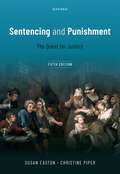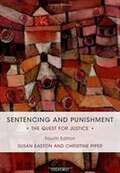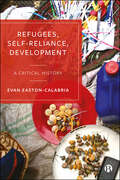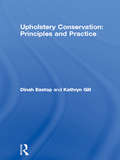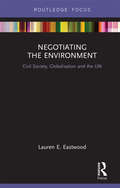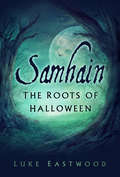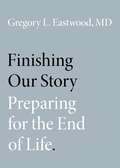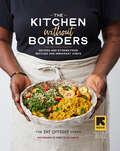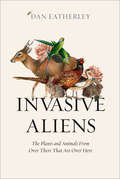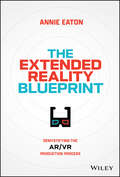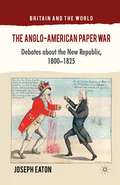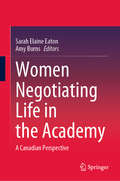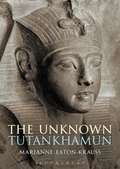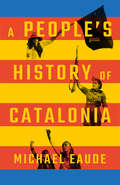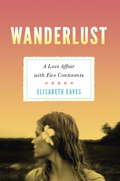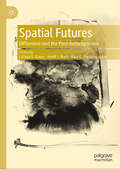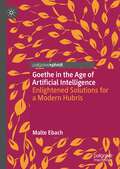- Table View
- List View
Sentencing and Punishment
by Susan Easton Christine PiperExamining the theory behind the headlines and engaging with current debates, this new edition provides thoughtful, impartial, and unbiased coverage of sentencing and punishment in the UK. Collectively, Susan Easton and Christine Piper are highly experienced teachers and researchers in this field, making them perfectly placed to deliver this lively account of a highly dynamic subject area. The book takes a thorough and systematic approach to sentencing and punishment, examining key topics from legal, philosophical, and practical perspectives. Offering in-depth and detailed coverage, while remaining clear and succinct, the authors deliver a balanced approach to the subject. Chapter summaries, discussion questions, and case studies help students to engage with the subject, apply their knowledge, and reflect upon debates. Fully reworked and restructured, this fifth edition has been updated to include developments such as the Sentencing Act 2020 and changes following the 2019 general election. This is the essential guide for anyone studying sentencing and punishment as part of a law or criminology course.
Sentencing and Punishment
by Susan Easton Christine PiperExamining the theory behind the headlines and engaging with current debates, this new edition provides thoughtful, impartial, and unbiased coverage of sentencing and punishment in the UK. Collectively, Susan Easton and Christine Piper are highly experienced teachers and researchers in this field, making them perfectly placed to deliver this lively account of a highly dynamic subject area. The book takes a thorough and systematic approach to sentencing and punishment, examining key topics from legal, philosophical, and practical perspectives. Offering in-depth and detailed coverage, while remaining clear and succinct, the authors deliver a balanced approach to the subject. Chapter summaries, discussion questions, and case studies help students to engage with the subject, apply their knowledge, and reflect upon debates. Fully reworked and restructured, this fifth edition has been updated to include developments such as the Sentencing Act 2020 and changes following the 2019 general election. This is the essential guide for anyone studying sentencing and punishment as part of a law or criminology course.
Refugees, Self-Reliance, Development: A Critical History
by Evan Easton-CalabriaEvan Easton-Calabria’s critical history of refugee self-reliance assistance brings new dimensions to refugee and international development studies. The promotion of refugee self-reliance is evident today, yet its history remains largely unexplored, with good practices and longstanding issues often missed. Through archival and contemporary evidence, this book documents a century of little-known efforts to foster refugee self-reliance, including the economic, political, and social motives driving this assistance. With five case studies from Greece, Tanzania, Pakistan, Uganda, and Egypt, the book tracks refugee self-reliance as a malleable concept used to pursue ulterior interests. It reshapes understandings of refugee self-reliance and delivers important messages for contemporary policy making.
Refugees, Self-Reliance, Development: A Critical History
by Evan Easton-CalabriaEvan Easton-Calabria’s critical history of refugee self-reliance assistance brings new dimensions to refugee and international development studies. The promotion of refugee self-reliance is evident today, yet its history remains largely unexplored, with good practices and longstanding issues often missed. Through archival and contemporary evidence, this book documents a century of little-known efforts to foster refugee self-reliance, including the economic, political, and social motives driving this assistance. With five case studies from Greece, Tanzania, Pakistan, Uganda, and Egypt, the book tracks refugee self-reliance as a malleable concept used to pursue ulterior interests. It reshapes understandings of refugee self-reliance and delivers important messages for contemporary policy making.
Upholstery Conservation: Principles and Practice
by Dinah Eastop Kathryn GillThis well referenced book provides an amply illustrated publication on upholstery conservation which discusses and reviews the issues related to the care, interpretation and treatment of upholstered furniture.Through many well illustrated case studies the inter-disciplinary collaboration fundamental to upholstery conservation, and the complex decision-making process involved in the treatment of upholstered furniture, are made evident. The case histories are contributed by leading international practitioners in the field and concern objects and collections in the care of English Heritage, the Victoria and Albert Museum, the Metropolitan Museum of Art and other internationally renowned institutions.Likewise, the contributors, from both sides of the Atlantic, are world-renowned specialists and leaders in this area of conservation working for the public and private sectors. The case histories, illustrated in colour, black and white and specially prepared line drawings, concern object treatment and documentation, the conservation of information, the function and the artefact. They range from the documentation of eighteenth century removable chair covers and the treatment of a nineteenth century carriage to a twentieth century foam-filled chair belonging to a museum.
Upholstery Conservation: Principles and Practice (Conservation And Museology Ser.)
by Dinah Eastop Kathryn GillThis well referenced book provides an amply illustrated publication on upholstery conservation which discusses and reviews the issues related to the care, interpretation and treatment of upholstered furniture.Through many well illustrated case studies the inter-disciplinary collaboration fundamental to upholstery conservation, and the complex decision-making process involved in the treatment of upholstered furniture, are made evident. The case histories are contributed by leading international practitioners in the field and concern objects and collections in the care of English Heritage, the Victoria and Albert Museum, the Metropolitan Museum of Art and other internationally renowned institutions.Likewise, the contributors, from both sides of the Atlantic, are world-renowned specialists and leaders in this area of conservation working for the public and private sectors. The case histories, illustrated in colour, black and white and specially prepared line drawings, concern object treatment and documentation, the conservation of information, the function and the artefact. They range from the documentation of eighteenth century removable chair covers and the treatment of a nineteenth century carriage to a twentieth century foam-filled chair belonging to a museum.
Negotiating the Environment: Civil Society, Globalisation and the UN (Routledge Focus on Environment and Sustainability)
by Lauren E EastwoodCivil society participants have voiced concerns that the environmental problems that were the subject of multilateral environmental agreements negotiated during the 1992 Rio processes are not serving to ameliorate global environmental problems. These concerns raise significant questions regarding the utility of negotiating agreements through the UN. This book elucidates the complexity of how participants engage in these negotiations through the various processes that take place under the auspices of the UN—primarily those related to climate and biological diversity. By taking an ethnographic approach and providing concrete examples of how it is that civil society participants engage in making policy, this book develops a robust sense of the implications of the current terrain of policy-making—both for the environment, and for the continued participation of non-state actors in multilateral environmental governance. Using data gathered at actual negotiations, the book develops concepts such as participation and governance beyond theory. The research uses participant observation ethnographic methods to tie the theoretical frameworks to people’s actual activities as policy is generated and contested. Whereas topics associated with global environmental governance are traditionally addressed in fields such as international relations and political science, this book contributes to developing a richer understanding of the theories using a sociological framework, tying individual activities into larger social relations and shedding light on critical questions associated with transnational civil society and global politics.
Negotiating the Environment: Civil Society, Globalisation and the UN (Routledge Focus on Environment and Sustainability)
by Lauren E EastwoodCivil society participants have voiced concerns that the environmental problems that were the subject of multilateral environmental agreements negotiated during the 1992 Rio processes are not serving to ameliorate global environmental problems. These concerns raise significant questions regarding the utility of negotiating agreements through the UN. This book elucidates the complexity of how participants engage in these negotiations through the various processes that take place under the auspices of the UN—primarily those related to climate and biological diversity. By taking an ethnographic approach and providing concrete examples of how it is that civil society participants engage in making policy, this book develops a robust sense of the implications of the current terrain of policy-making—both for the environment, and for the continued participation of non-state actors in multilateral environmental governance. Using data gathered at actual negotiations, the book develops concepts such as participation and governance beyond theory. The research uses participant observation ethnographic methods to tie the theoretical frameworks to people’s actual activities as policy is generated and contested. Whereas topics associated with global environmental governance are traditionally addressed in fields such as international relations and political science, this book contributes to developing a richer understanding of the theories using a sociological framework, tying individual activities into larger social relations and shedding light on critical questions associated with transnational civil society and global politics.
Samhain: The Roots of Halloween
by Luke Eastwood‘An excellent and comprehensive exploration of this fascinating subject.’ - Philip Carr-Gomm, author Druid Mysteries ‘Samhain was the entry point into winter, a time of hardship, cold and hunger … It was also a time of introspection, of communing with the dead and the otherworld – themes that have somehow survived, albeit distorted, into the modern era.’ The modern celebration of Halloween is derived from the ancient festival of the dead known in Ireland as Samhain. It is from Ireland that we have inherited most of our Halloween traditions, mainly through the diaspora. Delving into the ancient past, this book uncovers the history of this festival in Britain, Ireland and Brittany, including the forgotten goddess Tlachtga and the sacred temple of the Druids in Co. Meath, where the first Halloween fires were lit.
Finishing Our Story: Preparing for the End of Life
by Gregory L. Eastwood, MDDeath is the destiny we all share, and this will not change. Yet the way we die, which had remained the same for many generations, has changed drastically in a relatively short time for those in developed countries with access to healthcare. For generations, if people were lucky enough to reach old age, not having died in infancy or childhood, in childbirth, in war, or by accident, they would take to bed, surrounded by loved ones who cared for them, and fade into death. Most likely, they would have seen their parents and grandparents die the same way, and so this manner of dying would be familiar: it was part of the natural cycle of life. Now less than 25 per cent of Americans die at home, having reached much older ages than people would have dreamed of in past generations, often after surviving many illnesses and even diseases that would have been terminal for their grandparents. We are fortunate to live (and die) today, supported by myriad scientific, medical, and technological advancements, however we also face new problems as a result of the new way in which we die. We can no longer anticipate a peaceful waning at home with family. We know our lives will likely end in hospitals likely after we have endured grueling treatments to prolong life. We have to decide what decisions we want our loved ones, or care-givers, to make when we cannot choose for ourselves. We have to think about whether in any circumstances we would seek physician-assisted death. We know we face other questions as well, but we may not even know where to start. In the face of these decisions, we can feel daunted and afraid. The best remedy is information and planning. In this book, Gregory Eastwood - a physician who has cared for dying patients, served as an ethics consultant, and taught end of life issues to medical and other health profession students - draws from his substantial experience with patients and families to provide the information that will help us think clearly about the choices and issues we will face at the end of our own lives, and when faced with the deaths of our loved ones. With sensitivity and profound insight, Eastwood guides us through all the important questions about death and dying in straightforward, clear language, enhanced by real-life stories. Throughout, he shows us how we can take ownership of the way we want to die, when we must die, and feel more in control as death approaches.
Finishing Our Story: Preparing for the End of Life
by Gregory L. Eastwood, MDDeath is the destiny we all share, and this will not change. Yet the way we die, which had remained the same for many generations, has changed drastically in a relatively short time for those in developed countries with access to healthcare. For generations, if people were lucky enough to reach old age, not having died in infancy or childhood, in childbirth, in war, or by accident, they would take to bed, surrounded by loved ones who cared for them, and fade into death. Most likely, they would have seen their parents and grandparents die the same way, and so this manner of dying would be familiar: it was part of the natural cycle of life. Now less than 25 per cent of Americans die at home, having reached much older ages than people would have dreamed of in past generations, often after surviving many illnesses and even diseases that would have been terminal for their grandparents. We are fortunate to live (and die) today, supported by myriad scientific, medical, and technological advancements, however we also face new problems as a result of the new way in which we die. We can no longer anticipate a peaceful waning at home with family. We know our lives will likely end in hospitals likely after we have endured grueling treatments to prolong life. We have to decide what decisions we want our loved ones, or care-givers, to make when we cannot choose for ourselves. We have to think about whether in any circumstances we would seek physician-assisted death. We know we face other questions as well, but we may not even know where to start. In the face of these decisions, we can feel daunted and afraid. The best remedy is information and planning. In this book, Gregory Eastwood - a physician who has cared for dying patients, served as an ethics consultant, and taught end of life issues to medical and other health profession students - draws from his substantial experience with patients and families to provide the information that will help us think clearly about the choices and issues we will face at the end of our own lives, and when faced with the deaths of our loved ones. With sensitivity and profound insight, Eastwood guides us through all the important questions about death and dying in straightforward, clear language, enhanced by real-life stories. Throughout, he shows us how we can take ownership of the way we want to die, when we must die, and feel more in control as death approaches.
The Kitchen without Borders: Recipes and Stories from Refugee and Immigrant Chefs
by The Eat Offbeat ChefsA cookbook with wide-ranging roots and a very deep heart: 70 authentic, off-the-beaten-path recipes for delicious dishes from Syria, Afghanistan, Iraq, Iran, Eritrea, Venezuela, and other countries are shared by chefs who arrived in the US as refugees and immigrants and found work at the Eat Offbeat catering kitchen.
Invasive Aliens: The Plants And Animals From Over There That Are Over Here
by Dan EatherleyA Sunday Times Book of the Year A Telegraph Best Science Book of the Year A Waterstones Best Nature Book of the Year A unique history of plant and animal invaders of the British isles spanning thousands of years of arrivals and escapes, as well as defences mounted and a look to the future.
The Extended Reality Blueprint: Demystifying the AR/VR Production Process
by Annie EatonFollow a tried-and-tested approach to integrating augmented and virtual reality into your business The Extended Reality Blueprint focuses on design for non-gaming or gaming adjacent applications in extended reality (XR), including augmented and virtual reality. Author Annie Eaton is a leading producer of immersive content in the XR space. Many of Annie's clients come to her with the same questions, often not knowing where to begin as they seek to implement extended reality solutions into their business. This book presents the discovery and product development process through an immersive technology lens. You will walk through the XR production process and learn how to apply this technology directly within your organizations in a meaningful and effective way. Join leading businesses like Delta Air Lines, Mars Wrigley, Georgia-Pacific, and JLG Industries, and learn how top companies are leveraging XR for greater market share, engagement, and profit. Learn about the latest applications of extended reality (XR), including augmented and virtual reality. Discover the steps of the XR product development process, including how to find profitable uses of XR and decide on technology suites. Assemble effective teams of XR developers, designers, artists, and other key members to bring your projects to fruition and success. Learn from the real-world examples and lessons learned of businesses that have taken the leap into extended reality. The Extended Reality Blueprint, delivers a concrete, actionable process for brining extended reality into your organization and embracing this crucial technology to remain current.
The Extended Reality Blueprint: Demystifying the AR/VR Production Process
by Annie EatonFollow a tried-and-tested approach to integrating augmented and virtual reality into your business The Extended Reality Blueprint focuses on design for non-gaming or gaming adjacent applications in extended reality (XR), including augmented and virtual reality. Author Annie Eaton is a leading producer of immersive content in the XR space. Many of Annie's clients come to her with the same questions, often not knowing where to begin as they seek to implement extended reality solutions into their business. This book presents the discovery and product development process through an immersive technology lens. You will walk through the XR production process and learn how to apply this technology directly within your organizations in a meaningful and effective way. Join leading businesses like Delta Air Lines, Mars Wrigley, Georgia-Pacific, and JLG Industries, and learn how top companies are leveraging XR for greater market share, engagement, and profit. Learn about the latest applications of extended reality (XR), including augmented and virtual reality. Discover the steps of the XR product development process, including how to find profitable uses of XR and decide on technology suites. Assemble effective teams of XR developers, designers, artists, and other key members to bring your projects to fruition and success. Learn from the real-world examples and lessons learned of businesses that have taken the leap into extended reality. The Extended Reality Blueprint, delivers a concrete, actionable process for brining extended reality into your organization and embracing this crucial technology to remain current.
The Anglo-American Paper War: Debates about the New Republic, 1800–1825 (Britain and the World)
by J. EatonThe Paper War and the Development of Anglo-American Nationalisms, 1800-1825 offers fresh insight into the evolution of British and American nationalisms, the maturation of apologetics for slavery, and the early development of anti-Americanism, from approximately 1800 to 1830.
Women Negotiating Life in the Academy: A Canadian Perspective
by Sarah Elaine Eaton Amy BurnsThis book offers a new perspective on how Canadian women in the academy are re-conceptualizing and reconsidering their position as professionals. It examines central challenges associated with the lives of women scholars and higher education professionals, including their professional identity, institutional expectations, lessons learned throughout their career experiences in higher education, and navigating between multiple roles.In turn, the book highlights the importance of both formal and informal networks of support. Each contributing author presents authentic examples from her lived experiences as a woman in the academy, situating her personal narrative within previous research in the field. Taken together, the respective chapters equip readers with a deeper understanding of the experiences of women in the academic world. This book is inclusive in nature, showcasing experiences from women who are scholars, students and higher education professionals.The book makes a significant and unique contribution to the field of gender studies, with a focus on women negotiating life in the academic world and within the Canadian context. The evidence and insights shared here will benefit all scholars in women’s studies and comparative studies, as well as those considering a career in higher education.
The Unknown Tutankhamun (Bloomsbury Egyptology)
by Marianne Eaton-KraussFollowing the discovery of Tutankhamun's tomb in 1922, the story of the boy who became Pharaoh, died young, and was buried in splendor at the height of Egyptian civilization captivated generations. But there exists a wide discrepancy between that saga and what scholars have learned in the past few decades about the king's reign and its major significance for the history of Egypt.Marianne Eaton-Krauss, a leading authority on the boy king and the Amarna Period, guides readers through the recent findings of international research and the relevant documentation from a wide variety of sources, to create an accessible and comprehensive biography. Tracing Tutankhamun's life from birth to burial, she analyzes his parentage, his childhood as Prince Tutankhaten, his accession and change of name to Tutankhamun, his role in the restoration of the traditional cults and his own building projects, his death and burial, and the attitudes of his immediate successors to his reign.Illustrated with color and black-and-white images, the book includes extensive endnotes and selected bibliography, which will make it essential reading for students and scholars as well as anyone interested in Tutankhamun.
The Unknown Tutankhamun: A Biography Of The Unknown King (Bloomsbury Egyptology)
by Marianne Eaton-KraussThe reign of Tutankhamun was of major significance in the history of ancient Egypt. Following Howard Carter's discovery of the king's tomb in 1922, the story of the boy who became Pharaoh, died young and was buried in splendor at the height of Egyptian civilization captivated generations. But there exists a wide discrepancy between that saga and what scholarship has discovered in the last few decades about Tutankhamun's reign. A truer story is revealed, not by objects from his tomb, but by statuary, reliefs, paintings, and architecture from outside the Valley of the Kings. Marianne Eaton-Krauss, a leading authority on the boy king and the Amarna Period, guides readers through the recent findings of international research and the relevant documentation from a wide variety of sources, to create an accessible and comprehensive biography. Tracing Tutankhamun's life from birth to burial, she analyzes his parentage, his childhood as Prince Tutankhaten, his accession and change of name to Tutankhamun, his role in the restoration of the traditional cults and his own building projects, his death and burial, and the attitudes of his immediate successors to his reign.Illustrated with color and black-and-white images, the book includes extensive endnotes and selected bibliography, which will make it essential reading for students and scholars as well as anyone interested in Tutankhamun.
A People's History of Catalonia (People's History)
by Michael EaudeAt every home game of FC Barcelona, at 17 minutes and 14 seconds of play, the 100,000-capacity Camp Nou stadium is filled by the roar of “IN-DE-PEN-DÈN-CI-A!” Time stops for a second. History lives in the present... Catalonia's national consciousness has deep roots. There are countries twice the size with histories half as interesting. A People's History of Catalonia tells that history, from below, in all its richness and complexity. The region's struggle for independence has, for centuries, been violently resisted, the Catalan language suppressed and its leaders jailed. But the fight of an oppressed nation for its sovereignty has often dovetailed with that of a militant working class for social justice. From the peasant revolts of the 15th century and the siege of Barcelona in 1714, to defeat in the Spanish Civil War, and the slow re-emergence of the workers' movement and anti-Francoist resistance in the years that followed, Michael Eaude tells a compelling story whose ending has yet to be written.
A People's History of Catalonia (People's History)
by Michael EaudeAt every home game of FC Barcelona, at 17 minutes and 14 seconds of play, the 100,000-capacity Camp Nou stadium is filled by the roar of “IN-DE-PEN-DÈN-CI-A!” Time stops for a second. History lives in the present... Catalonia's national consciousness has deep roots. There are countries twice the size with histories half as interesting. A People's History of Catalonia tells that history, from below, in all its richness and complexity. The region's struggle for independence has, for centuries, been violently resisted, the Catalan language suppressed and its leaders jailed. But the fight of an oppressed nation for its sovereignty has often dovetailed with that of a militant working class for social justice. From the peasant revolts of the 15th century and the siege of Barcelona in 1714, to defeat in the Spanish Civil War, and the slow re-emergence of the workers' movement and anti-Francoist resistance in the years that followed, Michael Eaude tells a compelling story whose ending has yet to be written.
Wanderlust: A Love Affair with Five Continents
by Elisabeth EavesSpanning fifteen years of travel, beginning when she is a sophomore in college, Wanderlust documents Elisabeth Eaves’s insatiable hunger for the rush of the unfamiliar and the experience of encountering new people and cultures. Young and independent, she crisscrosses five continents and chases the exotic, both in culture and in romance. In the jungles of Papua New Guinea, she loses herself-literally-to an Australian tour guide; in Cairo, she reconnects with her high school sweetheart, only to discover the beginning of a pattern that will characterize her life over the long-term: while long-distance relationships work well for her, traditional relationships do not.Wanderlust, however, is more than a chronological conquest of men and countries: at its core, it’s a journey of self-discovery. In the course of her travels, Eaves finds herself and the sense of home she’s been lacking since childhood-and she sheds light on a growing culture of young women who have the freedom and inclination to define their own, increasingly global, lifestyles, unfettered by traditional roles and conventions of past generations of women.
Spatial Futures: Difference and the Post-Anthropocene
by LaToya E. Eaves Heidi J. Nast Alex G. PapadopoulosSpatial Futures invites readers to imagine power and freedom through the lens of the ‘Black Outdoors’, a transdisciplinary spatial concept that operates beyond the planetary, stratigraphic confines of the ‘Anthropocene’. The chapters collectively point to the ontological-epistemological contradictions involved in forging liberatory spatial futures. Bringing new spatial imaginaries to bear in and outside geography, the book refuses the strictures of the ‘cenic’, entertaining difference as world-making.
Goethe in the Age of Artificial Intelligence: Enlightened Solutions for a Modern Hubris
by Malte EbachInside you lies a precise scientific instrument – the ability to observe Nature and recall past experiences. You were born with it and you use it every day. You can be trained to use it more effectively to, for example, compare and discover new species of organisms or new minerals. Our senses do have limitations, and we often use microscopes, telescopes and other tools to aid our observation. However, we benefit from knowing their limitations and the impact they have on our ability to combine our observations and our experience to make decisions. Once these tools replace our direct observation and our experience we ourselves become disconnected from Nature. Scientific practice turns into well-meant opinions out-weighing empirical evidence. This is happening now in the current age of big data and artificial intelligence. The author calls this the Modern Hubris and it is slowly corroding science. To combat the Modern Hubris and to reconnect with Nature, scientists need to change the way they practise observation. To do so may require the scientist to transform themself. One person who successfully did this was Johann Wolfgang von Goethe. His journey demonstrates how one man attempted to take on the Modern Hubris by transforming his life and how he saw Nature. Following Goethe’s transformation teaches us how we can also reconnect ourselves with Nature and Natural science.
